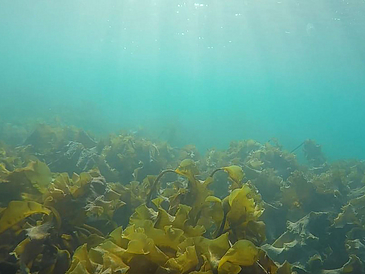Doctoral student Sarina Niedzwiedz and Professor Kai Bischof recently published the results of the study in the renowned international journal Limnology & Oceanography. The two researchers had studied two different types of kelp off the coast of Spitsbergen. These large brown algae form extensive underwater forests in Arctic fjords. Their role in those ecosystems can be compared to that of trees in forests on land. For example, they serve as food, habitat, and nursery for many species. They also conserve fish stocks and protect coasts by slowing down waves. They are therefore also of great socioeconomic importance.
Due to climate change, many environmental factors in kelp habitats are changing drastically. Rising water temperatures have already led to the decline of kelp forests in southern distribution areas, such as off the Atlantic coast of northern Spain. In the Arctic, on the other hand, warming water can cause some types of kelp to spread. However, there is another development that stands in the way of this: “Due to glacier melting and the thawing of permafrost soils, sediments like fine sand and silt are increasingly entering the water due to erosion,” says Niedzwiedz. Where the concentration of sediment is particularly high – in so-called sediment plumes – less light is available to the kelp. But kelp need light in order to carry out photosynthesis and grow. The Bremen researchers thus investigated to what extent there is enough light in the sediment plumes to maintain the temperature-related spread of kelp in the Arctic.
Increasing Temperatures: Types of Algae React Differently
In the Kongs Fjord near the island of Spitsbergen, the researchers took samples of two species of kelp that are common in the Arctic: Saccharina latissima and Alaria esculenta. In the laboratory, they exposed the samples to water at different temperatures. In the process, they measured changes in chlorophyll and carbon and nitrogen content in the kelp. They also determined their respiration and photosynthesis rates and determined the minimum amount of light the kelp need to grow. They also determined the light conditions in the sediment plumes in the fjord. Later, using the measured light requirements of the kelp and the light conditions in the fjord, they were able to model the maximum distribution depth of the kelp at different water temperatures.
The team found significant differences between the two types of kelp in their response to rising temperatures. The metabolism of S. latissima accelerated with rising temperatures; the algae had more energy at their disposal. However, the increased metabolic rates reduced the algae’s carbon content. The lower carbon stores could impair their ability to survive the polar night in warmer waters. Compared to S. latissima, the second species, A. esculenta, had a higher concentration of the pigment chlorophyll a, which is responsible for photosynthesis. However, this species also required higher light intensities to grow under warmer conditions. Higher temperatures combined with low light intensities therefore have an unfavorable effect on both species.
Prognosis: Arctic Underwater Forests More Likely in Shallower Areas in Future
The researchers concluded that the species composition and distribution of future Arctic kelp forests will change. “As higher sediment concentrations lead to a reduction in light intensity and quality, the distribution depth of the kelp is likely to shift to shallower regions,” says Bischof. This reduces the area where kelp forests in the Arctic will be able to grow. This in turn will have far-reaching consequences for the entire ecosystem. Kelp are at the base of the food web and serve as food, habitat, and nursery area for many species. With the loss of kelp forests, many species in the Arctic will be deprived of their source of subsistence.
Original publication: Niedzwiedz, S., and K. Bischof. 2023. Glacial retreat and rising temperatures are limiting the expansion of temperate kelp species in the future Arctic. Limnol. Oceanogr. 9999:1–15. doi: 10.1002/lno.12312
Further Information:
https://aslopubs.onlinelibrary.wiley.com/doi/full/10.1002/lno.12312 (Link to publication)
www.uni-bremen.de/marbot
www.face-it-project.eu
Contact:
Sarina Niedzwiedz
Marine Botany; Faculty of Biology/Chemistry
University of Bremen
sarinaprotect me ?!uni-bremenprotect me ?!.de
Professor Kai Bischof
Marine Botany; Faculty of Biology/Chemistry
University of Bremen
kbischofprotect me ?!uni-bremenprotect me ?!.de

